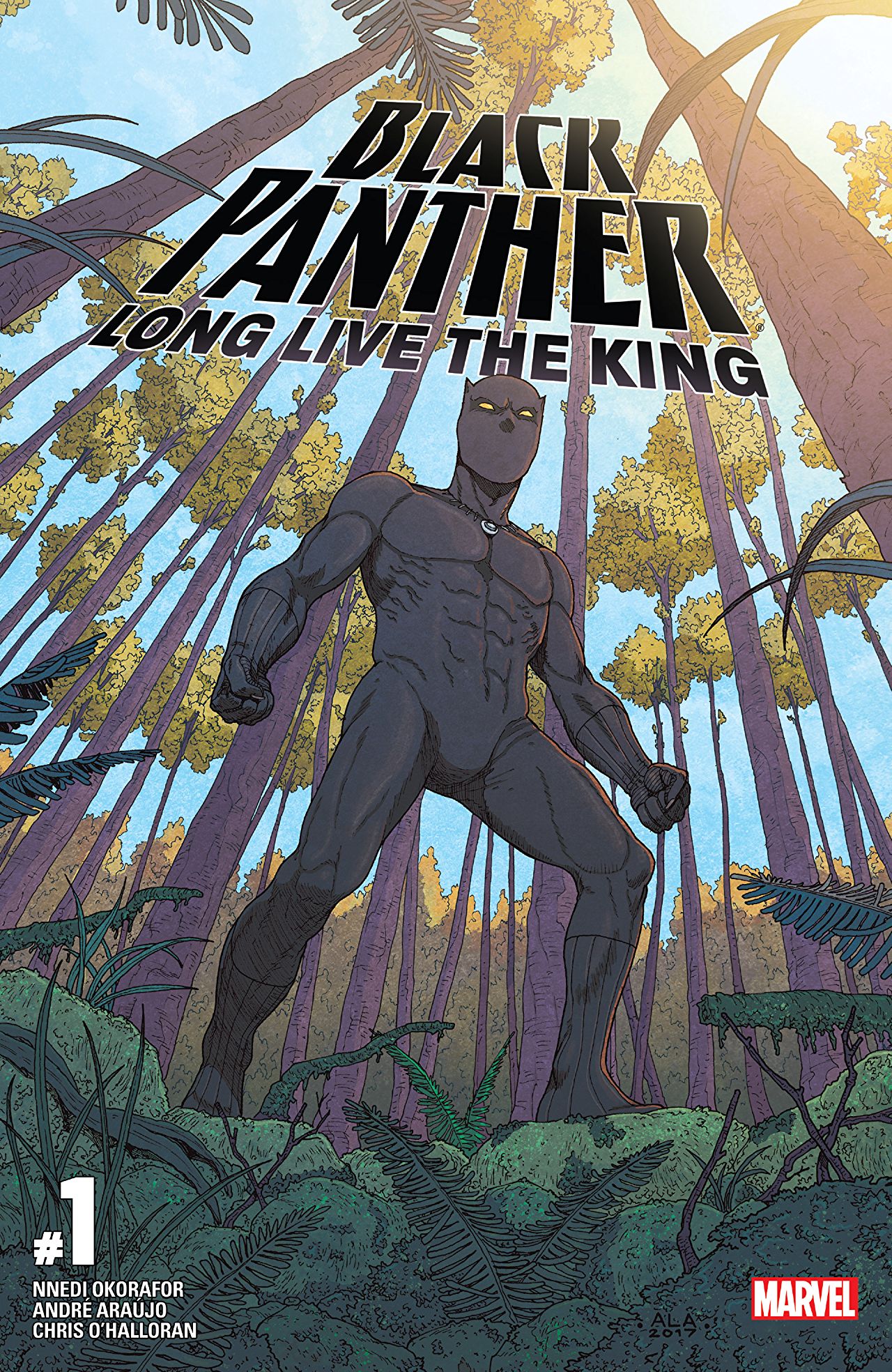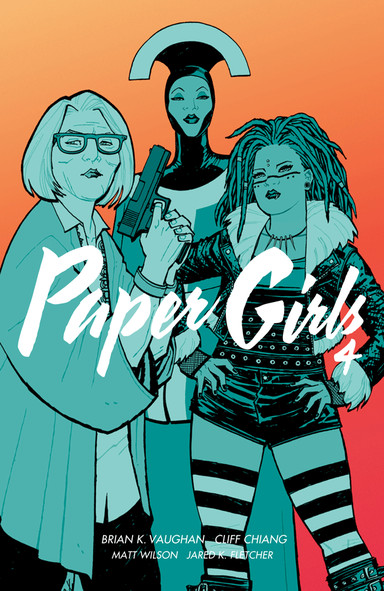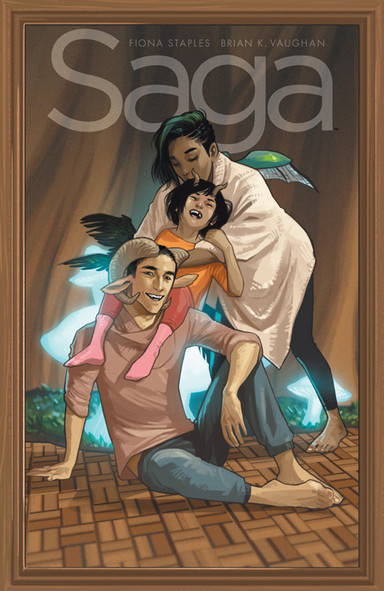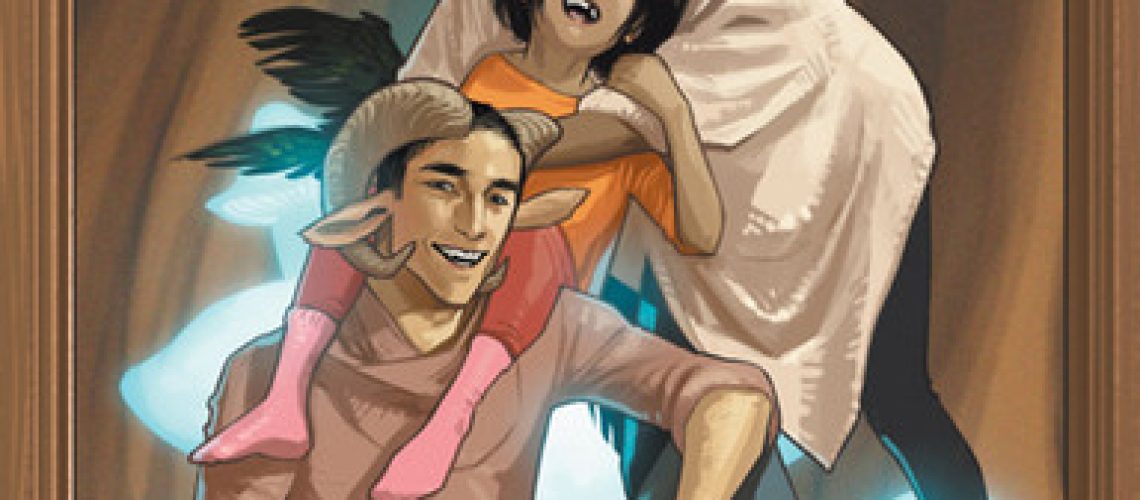Welcome to the latest installment of my comics review column here at Skiffy & Fanty! Every month, I use this space to shine a spotlight on SF&F comics (print comics, graphic novels, and webcomics) that I believe deserve more attention from SF&F readers.
This month, I’m going to take a look at the nominees for this year’s Best Graphic Story Hugo Award. Warning: these reviews contains spoilers!
As regular readers will know, I’ve been in the habit of using this space to both recommend works that might otherwise be overlooked by Hugo voters during nomination season and taking a look at the short list in advance of the deadline for voting. If you aren’t already familiar with this year’s ballot, you can read the complete list here, but if you don’t want to click away, here are the finalists for this year’s Best Graphic Story Hugo:
- Abbott written by Saladin Ahmed, art by Sami Kivelä, colours by Jason Wordie, letters by Jim Campbell (BOOM! Studios) — read my review here.
- Black Panther: Long Live the King written by Nnedi Okorafor and Aaron Covington, art by André Lima Araújo, Mario Del Pennino and Tana Ford (Marvel)
- Monstress, Volume 3: Haven written by Marjorie Liu, art by Sana Takeda (Image Comics) — read my review here.
- On a Sunbeam by Tillie Walden (First Second) — read my review here.
- Paper Girls, Volume 4 written by Brian K. Vaughan, art by Cliff Chiang, colours by Matt Wilson, letters by Jared K. Fletcher (Image Comics)
- Saga, Volume 9 written by Brian K. Vaughan, art by Fiona Staples (Image Comics)
As you can see, I’ve reviewed and recommended several of these already — one, I loved so much that I reviewed it twice! In the interest of brevity and avoiding repetition that would bore even me, however, the reviews below will only include the works I haven’t already covered.
As with last year, I’m not going to try to guess what’ll win, or tell you what I think should — although you’ll obviously be able to infer some of my preferences from the reviews! I encourage you to seek out, read, and draw your own conclusions.
 Black Panther: Long Live The King
Black Panther: Long Live The King
Writers — Nnedi Okorafor, Aaron Covington
Artists — André Lima Araújo, Mario Del Pennino, Tana Ford
Oh dear. Look, I’m sorry to start on a less-than-entirely-happy note, and I know how much people love both Black Panther and Nnedi Okorafor’s writing, but this is perhaps the weakest of this year’s finalists. It’s not the fault of Okorafor (who, to be clear, didn’t write all the material collected in this volume) or any of the other creators. The writing is well-paced and plotted and the characters pop. The art is straightforward but effective visual storytelling. The problem is that not much happens.
As someone who mostly isn’t a reader of Marvel comics except when they land on the Hugo ballot, I don’t have a strong sense of what else was going on in Marvel continuity when these stories were first published, but whatever it was, they’re mostly isolated from it and kept within the frame of Wakanda. And that’s not inherently a problem, because Wakanda is fascinating. I’m sure that dedicated Black Panther fans, whether they were first drawn in via comics or via the MCU, will enjoy delving into T’Challa’s and Wakanda’s past.
But this is essentially a collection of side stories. Black Panther: Long Live The King is a perfectly fine collection of perfectly fine superhero tales, but it’s unfortunately not particularly consequential. Readers who want to see the broader Marvel Universe are likely to find less to chew on than they’d like. More importantly, nothing substantive changes for the characters or the setting. It feels, to me at least, like a bit of a letdown.
The concluding story in the volume, however, is an exciting, engaging departure. As one of the issues written by Okorafor, it features a young Nigerian woman on her first visit home since becoming the new partner/host/whatever of the Venom symbiote. It’s only tangentially related to the other stories, and the art style is quite different from the Black Panther material. Although it too has few connections to the broader Marvel Universe — and it is a comparatively low-stakes, personal story — it feels far more interesting and important. As a story about someone who’s learning, growing, and changing in her new role as a superhero who draws her power from literally sharing her body with a bloodthirsty monster, it matters more as a narrative than an embittered old friend of T’Challa’s we’ve never heard of before (and likely never will again) showing up to cause trouble.
It’s also the story that made it clear to me that Nnedi Okorafor, in addition to all her other strengths, has an excellent grasp of comics storytelling, when she can make the material clearly her own. I look forward to reading more from her in the form, like the Shuri series from Marvel and her own LaGuardia from Dark Horse, which ties in to her acclaimed Binti novellas — comics where she has the space to make her characters change and grow, and to make her narratives evolve and reach a real conclusion.
Black Panther: Long Live The King is published by Marvel Comics. It’s available wherever fine comics are sold.

Paper Girls, Volume 4
Writer — Brian K. Vaughan
Artist — Cliff Chiang
Colors — Matt Wilson
Letters — Jared K. Fletcher
Paper Girls continues to be a very engaging, trippy time-travel narrative. I’m not sure why it’s perennially a Hugo finalist but has never taken home the prize. Maybe it’s every Brian K. Vaughan reader’s second choice. Or maybe it’s that having multiple Vaughan titles on the ballot serves to illustrate what I’m going to gently call consistent approaches to narrative structure in his writing.
In short, there’s a model that Vaughan consistently writes to. That’s not a bad thing, but it becomes more evident the more of his long-form work you read in close succession and it can be … wearing. Because the pivot almost always seems to be that someone shows up and makes things weirder and worse. It can be tiring to read when you know that the characters — the characters that Vaughan is a good enough writer to get me really attached to! — have an entire volume of pain ahead of them and that they’ll finish in a worse place than they started. That he also punctuates the bad stuff with moments of peace and grace doesn’t make it easier when you’ve figured out that it’s coming. I mean, yes, the narrative tension of uncertain intentions is good. But when a new character who seems to know more about the situation than they’re letting on shows up to help the protagonists, it doesn’t actually serve narrative tension for me to expect the coming betrayal from moment one.
With that in mind, Volume 4 is a fun-as-hell installment of Vaughan and Chiang’s story of four young women who go out delivering newspapers one morning in 1988 and get caught up in a reality-warping time war. I remain invested in and attached to the titular characters despite knowing that more dark times are coming for them. This is also the volume that makes it very clear that Paper Girls is ultimately a family saga, albeit one that stretches across all of human prehistory, history, and post-history. I even emerged with a wild fan theory about Dr. Braunstein, so ask me about that sometime.
Paper Girls, Volume 4 is published by Image Comics. It’s available wherever fine comics are sold.

Saga, Volume 9
Writer — Brian K. Vaughan
Artist — Fiona Staples
I know that almost all of you love Saga, but I have to admit the the more of it I read, the less I love it. That aforementioned consistent approach to narrative structure really wears me down, especially with volumes like this one where the moments of peace and grace are not only fleeting but also actually foreshadow the coming weirder and worse. Vaughan is a good writer, but one who seems to rely heavily on his favorite tools — like those big weird bad dramatic reversals and snappy quippy patter. And again, those things all work — or can. But for me, at least, they work best in smaller doses where the details of plot and character are in the foreground and make the recurring patterns of dramatic beats and dialogue less obvious. It’s not badly done, but it feels samey when I read one collected volume written by Vaughan. After several in quick succession, it’s wearying.
Fiona Staples, on the other hand, remains an artistic marvel, and it’s down to her bravura storytelling chops and ability to convey emotion with power and economy that the somewhat telegraphed turning points in this volume hit as hard as they do. Staples can do things no one else can with her characters, depicting grief, the heartbreak of facing a universe that’s betrayed your naive, optimistic hopes in the faces and body languages of what would otherwise be goofy-looking comic book alien critters.
I hope that the break that the creators are taking as of this volume, which they’ve confirmed marks the mid-point of the series, allows Vaughan to come back to the series refreshed and perhaps with some new approaches in his toolkit. The pieces are all there for a second half that makes the first pale in comparison — and that’ll make me love Saga as much as the rest of you do.
Saga, Volume 9 is published by Image Comics and is available everywhere that fine graphic literature is sold.
Disclosures and Acknowledgements:
I have no personal or professional relationship with the publishers or creators of these works. I obtained my own copies for review, in some cases purchasing them and in some, borrowing them from the library — libraries are awesome, so please support yours!
I would like to acknowledge that Toronto, and the land it now occupies, where I live and work, has been a site of human activity for 15,000 years. This land is the traditional territory of the Huron-Wendat and Petun First Nations, the Seneca, and most recently, the Mississaugas of the Credit River. The territory waswha the subject of the Dish with One Spoon Wampum Belt Covenant, an agreement between the Iroquois Confederacy and Confederacy of the Ojibwe and allied nations to peaceably share and care for the resources around the Great Lakes. This territory is also covered by the Upper Canada Treaties. Today, the meeting place of Toronto is still the home to many Indigenous people from across Turtle Island. I am grateful to have the opportunity to live and work in the community of Toronto, on this territory.







